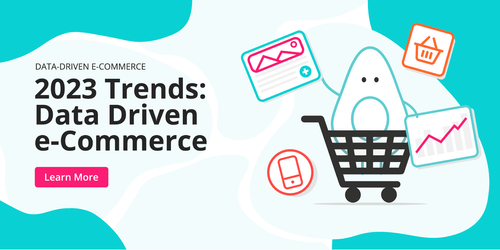Data-Driven Business
20.01.2021
8 minutes read
Data driven business trends - 2023
What trends await us in business in 2023? Business experts write about their data-driven predictions for 2023, and the trends to follow.

List of Contents
What trends await us in business in 2023? Business experts write about their data-driven predictions for 2023, and the trends to follow. In 2023, implement a data-driven culture into your business and gain further success in your industry.
Data-driven business trends for 2023
Paulina Walkowiak
Co-founder & CEO at CUX

Record results of CUX show me that we’re in the middle of data-driven transformation. The world is changing with no doubt, and crises can surprise our businesses when least expected, so we have to be prepared to adjust, shift, or even pivot. Using data to prioritize the development of digital products or to better specify or redefine our target groups becomes a standard.
Companies all over the world, after choking on big data and overwhelming analytics, try to improve their processes step by step. The lack of analytical skills is also a fact and the market needs at least a few years to fill it up, so simplifying the processes, and adding user perspective to our websites and products is a must-have without questioning.
In the past years combining quantitative and qualitative perspectives was an innovation for early adopters and small, agile companies. Now is a game for the A-game players so the shift is real.
Read Paulina's predictions about 2022 >
Joanna Parasiewicz
Head of Communication & Marketing, CEE at OVHcloud

2023 will be a trying time. Challenges inspire constructive ideas, and difficult times harden companies
In last year's trends, we put forward the thesis that the growing awareness of consumers and a huge number of offers will force changes in shaping the customer's journey. This year, due to galloping inflation, the bar has been even raised: we address our offer to an attentive and sensitive customer that eliminates unnecessary expenses and looks for savings.
This allows us to conclude that the coming months will become a litmus test for companies of decisions made earlier:
- Are we truly flexible?
- Are we working with the right people?
- Have we managed to proof-seal the expenditures?
It’s quite a trick to set up or maintain a business in conditions of rampant inflation, budget cuts and diminishing demand. Nevertheless, challenges inspire constructive ideas, and difficult times harden companies. For example, Airbnb, Uber, WhatsApp… and Apple, a company that began its global operations in the 70s, right after the oil crisis, were the winners of the last economic crisis of 2007-2009.
Technological development enables savings, firstly by offering choice, secondly by flexibility. Those who meet the needs of cautious and reserved customers while operating in dynamic market changes will win. Those who have the ability to make quick changes in the offer they direct to the market built into their business model. And it’s the technology that helps a lot to achieve that.
Aleksander Paczek
Co-founder at BluzUP

At BluzUp, I am responsible for the development of sales, which is why I would like to draw attention to this. In most SMEs and startups, the most important KPI is sales growth.
In 2023, it is worth paying attention to two other factors that may be crucial for the development or even survival of the company:
- Team effectiveness - how many leads actually go to the next stages of the funnel, and how many are blown.
- Gross margin - how profitable or unprofitable are the projects for your business.
What we focus on in BluzUp in 2023 is an NPS survey among our clients and collecting feedback from over 60% of completed projects.
Data-driven business trends for 2022
Paulina Walkowiak
Co-founder & CEO at CUX

Data-driven business is not a goal to aim for anymore. It’s a fact.
For me, as an analytical tool founder, it has at least two layers. First, in the upcoming cookieless future, we have to be ready for optimization not based on an ads budget, but on knowing your clients’ needs in any way. Second, if you want to grow, you have to measure the growth. There is no other way to optimize if you do not measure where you are. Thus, developing innovative businesses requires smart data-based decisions and recalculating everything constantly. Being data-driven means being smarter and ready for long-term development. On one hand, the lack of users’ behaviors analytics is typical for a hype business based on a temporary trend. On the other hand, if you plan to grow your company and build a significant market advantage, you have to use data that really matters
Robert Paszkiewicz
VP Central and Eastern Europe at OVHcloud

We are facing a revolution that started some time ago. And is gaining momentum now. Growing customer awareness and a huge number of offers are forcing changes in the philosophy of addressing services and in shaping the customer’s buying journey.
Most people believe that the pandemic impact was negative. Then again, their outlook towards the future is more than positive (according to the SODA 3rd business survey).
The sentiment increases. User experience, fulfilled promises to customer expectations, quality, and impact. In fact, how we communicate the promise and deliver on it is becoming strategic. And surely will be the factors that will shape our reality.
Although 90% of the Polish companies collect data, very few know how to read it and use it, as OVHcloud’s research shows. A data-driven approach, which we are only just learning, will become the engine that enables conscious and attentive companies to reach the next level. Of course, data-driven marketing will help stand out from the crowd. And, what’s more important, it’s available to any business, regardless of size.
This means we can all win from it.
Natalia Kuźma
Co-founder & CEO at DiveInData

The capability to understand customer needs and keep an eye on competitors’ moves nowadays is a must.
It isn’t easy to get a competitive edge. And it’s challenging to maintain one. In fact, data-driven business decisions, enhance the likelihood of achieving business goals by 77% (Deloitte, 2019). Hence, market intelligence is becoming ever more widespread. For this reason, analyzing the competitive landscape and gaining competitive insights to improve business performance should be an integral part of operating in every industry. Even small companies can get to essential data like competitors’ websites, opinions about their products, or customer demographics. Insights based on those, and other data help determine the right goals, minimize risk, and establish competitive differentiators.
Konrad Pabiańczyk
Business Architect at UnityGroup**

There are a few interesting developments to look forward to this year. Recent changes in consumer behaviors will accelerate, and businesses will adapt even faster to better serve these needs. Look out for the rise of Q-Commerce (quick-commerce), hyper-personalized browsing experience, and process mining as a method for improving processes and eliminating inefficiencies.
Q-commerce
- Consumers will continue to eschew in-store shopping for a more virtual experience. The pandemic allowed for delivering food to become standard, but only very recently have we seen products being delivered in 15 minutes or less. What was advertised as the best solution for missing ingredients may well become a corner store killer.
Unique browsing and hyper-personalization
- Websites will become even more personalized. Two consumers sitting next to each other could be served up entirely different websites. This will not only relate to copying or as, but to products themselves — different locations can have varied preferences. This is often seen in physical stores, where the assortment reflects local preferences but will become even more pronounced online.
Process mining for churn prevention and shopping cart drop-off
- Process mining takes event logs and combines them with data science techniques to determine where there is room for improvement. Such methods will be combined with existing UX research to eliminate abrasive touchpoints for a seamless shopping experience. It will be taken further to assess behavior before, during, and possibly after a shopping cart was dropped to help explain why.
Michał Szklarski
Board Member at e-point

Business owners and e-commerce managers know very well how difficult it is to acquire customers. We do a lot of work managing paid traffic or analyzing tons of traffic data. We constantly encourage the user to visit our website, hoping that this process will increase the conversion rate. Meanwhile, it frequently happens that a slow mobile site or app, in addition to poor usability, can effectively discourage purchases, despite so many efforts.
When it comes to speed, users are mainly concerned with the smooth loading of content. It is worth emphasizing that the overall efficiency should be associated with the high responsiveness of the mobile site and maintaining the stability of elements during loading. Such actions were taken, among others, recently by Orange, which significantly improved their conversion rate. These elements have an impact on the reception of ads, as well as (which was introduced in the summer of this year) on search engine ranking.
Adam Bogacki
Associate at COBIN Angels
As e-commerce has been strongly accelerating, fuelled by the COVID outbreak, there is a significant rebuilding process going on in this market. Third-party sales in Amazon’s GMV are responsible for over 50% of the total.
This opportunity on the market is being covered by e-commerce roll-ups, which are on the rise now. The concept assumes acquiring, running, and consolidating small and mid-size e-commerce stores or brands simultaneously. Synergies and scale effect make them grow faster than standalone. Therefore, they also get access to huge scopes of data with clients’ behavior that may help them to make more data-driven decisions in line with clients’ expectations. While huge amounts have already been invested in companies like Thrasio – probably the largest player on the market, Perch, Berlin Brands Group, Opontia, the smaller players are acting on CEE and the African market. In the upcoming year, the trend may be continued with a strong focus on smaller brands being acquired.
_
Want to harvest the freshest analytical crops? Sign up for the cux.io nourishing newsletter! Be careful! We may grow on you! 🥑 😉

27/12/2022
8 minutes read
Data driven ecommerce - 2023 trends
What trends await us in data driven e-commerce in 2023? We’ve asked experts for their 2023 predictions for online shops. How to make your e-commerce more data driven?
Read more
16/12/2021
8 minutes read
Big data driven marketing trends 2023
What trends in data-driven marketing are ahead of us in 2023? We asked experts about their predictions for 2023 in terms of marketing activities.
Read more

